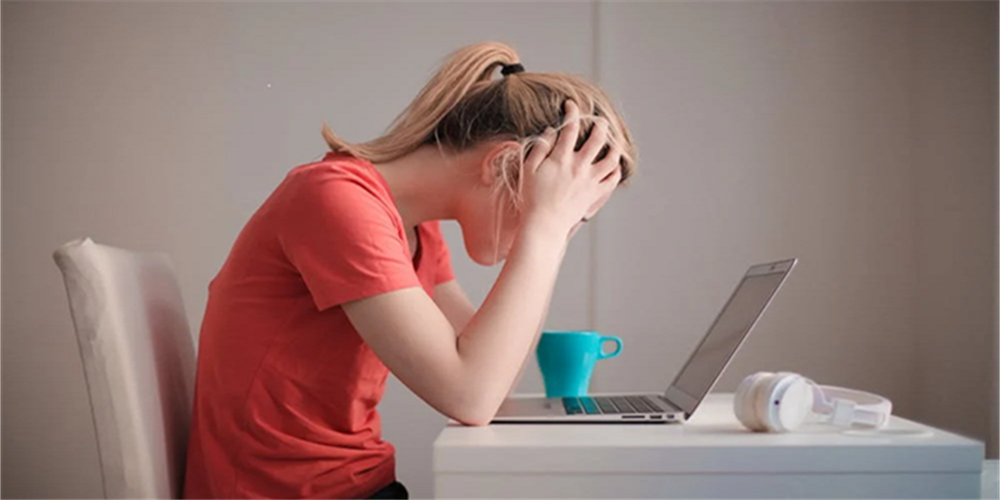

The first time I ever saw someone have an intense bout of anxiety was in college.
We were sitting outside of our statistics class. My classmates and I were waiting for our professor when (seemingly out of nowhere) one of my classmates started screaming “No! No! No!” — over and over again.
Within seconds, her body slammed to the ground and she continued screaming while banging her fist on the ground. My professor soon arrived to help her (along with an ambulance) and suffice it to say, the class was canceled.
My classmate was a strong, tall, powerhouse — almost six feet tall. She loved to laugh and joke around in class, so to see her like this was a shock to everyone who witnessed it.
But what I and the rest of the class didn’t know about her, was that she had something called panic disorder, which manifests through extreme anxiety.
That image has been forever ingrained in my memory. That’s when I understood the toll that an anxiety disorder can take on a person’s life, and one of the main reasons I became a mental health advocate and coach.
What is an anxiety disorder?
Anxiety is a natural emotion characterized by temporary worry or fear that can occur as a result of stress (i.e., before taking a test or dealing with a problem at work).
Acute anxiety develops suddenly and goes away quickly. It’s a part of the fight-or-flight reaction. Under stress, the autonomic nervous system (which controls involuntary responses) kicks in. It speeds up our heart rate and makes sure that we have enough glucose to take action.
However, this system was designed for short-term stressors. It’s not so helpful with chronic stress. Chronic anxiety develops slowly, worsens over time, and can damage a person’s mental well-being.

An anxiety disorder is characterized by excessive fear and excessive anxiety. People with anxiety disorders experience an intense fear and worry that doesn’t go away, and even gets worse over time if left untreated.
Contrary to common belief, an anxiety disorder is not centered around mood. It’s a mental health challenge with severe anxiety (though it can affect your mood too).
There are several different types of anxiety disorders, although they share several main symptoms.
What are the symptoms of anxiety disorders?
Anxiety can take many forms. Symptoms often involve uncomfortable mental and physical experiences that impact your life, like excessive worrying, body tension, headaches, and muscle pain.
Other possible anxiety disorder symptoms include:
- Increased heart rate or heart palpitations
- Rapid breathing
- Restlessness
- Trouble concentrating
- Fatigue
- Difficulty falling asleep
- Muscle tension
- Disruption in immune, digestive, cardiovascular, and reproductive systems
- High blood pressure
Anxiety — and the related stress — can also put you at a higher risk for developing other physical health problems and mental illnesses. The hyperactive sympathetic nervous system (part of that autonomic system discussed earlier) can suppress the immune system and take a physical, as well as mental, toll.
What are the most common causes of anxiety?
Anxiety — as well as many other mood disorders — is often attributed to the diathesis-stress model. This is the term behavioral scientists use to describe the combination of genetic and environmental factors that contribute to extreme anxiety. It’s theorized that some individuals have a genetic predisposition, or vulnerability, to extreme anxiety. This vulnerability is exacerbated by life stressors, or risk factors.
The risk factors for each type vary, but some general factors include:
- Behavioral inhibition or a temperamental shyness (often noticed in early childhood)
- Exposure to negative or stressful life events in childhood or adulthood
- A history of anxiety or common mental health challenges that run in biological families
- Physical health conditions like thyroid issues and heart arrhythmia
- Substances (especially substance abuse) such as caffeine, sugar, drugs, tobacco, and alcohol
What is an anxiety attack?
The experience my classmate had was a fairly dramatic example, but it’s characteristic of the extreme fear that accompanies an anxiety attack. Panic attacks, as they’re also known, can be noisy or subtle. They often come seemingly out of nowhere, and the symptoms can vary widely.
On the “mild” end, panic attacks often include increased heart rate, shortness of breath, racing thoughts, and feelings of anxiety. More severe anxiety attacks, however, can include chest pains, dizziness, and a feeling of dread. Many people report feeling as if they were about to die. It’s not uncommon for people to go to the emergency room, believing that they’re having a heart attack.
Sometimes, the panic triggers are identifiable. However, it’s more likely that the episodes may come unexpected. Regardless of whether the trigger is known or unknown, panic attacks should be treated immediately.
Panic attacks are a feature of several different types of anxiety disorders.
What are the 7 types of anxiety?
According to the National Institute of Mental Health (NIMH) Expert Dr. Krystal Lewis, anxiety disorders are the most common mental health condition in adults. Anxiety disorder is a term that refers to a collection of specific diagnoses, each with their own trademark symptoms. The DSM identifies several different types of anxiety disorders. These include generalized anxiety disorder, post-traumatic stress disorder, panic disorder, phobias, social anxiety, agoraphobia, and separation anxiety.
In this section, we’ll go over each of them.
Generalized anxiety disorder
This type of disorder displays excessive anxiety or worry on most days for at least six months.
Worries can be about several things related to personal health, work problems, interacting with others, and general routine life circumstances. As a result, there can be significant problems at work, home, school, and with social interactions.
Post-traumatic stress disorder
When someone has experienced a major life stressor, the trauma can result in post-traumatic stress disorder (PTSD). PTSD usually shows up as a reaction to certain triggers. People get “stuck” in the traumatic event and are immediately transported back there whenever they experience related stimuli. For example, someone who was in a terrible car crash may have panic attacks while driving. People with PTSD may go to great lengths in their daily lives to avoid their triggers.
Panic disorder
Panic disorder is characterized by unexpected or recurring panic attacks. A panic attack includes a sudden or intense fear that seems to come out of the blue and typically peaks within minutes.
These attacks can be triggered by a feared situation or object (or can come on unexpectedly). During a panic attack, people often experience feeling out of control and afraid that something bad’s going to happen. They describe it as a feeling of impending doom.
People with panic disorders often try to head off panic attacks by avoiding people, places, things, and behaviors that can trigger an attack. Unfortunately, these avoidances can cause significant problems in all areas of their lives due to an obsession with avoiding triggers (leading them to miss out on social, family, and work experiences).
Phobias
People who have a specific phobia experience intense fear or anxiety about specific objects or situations. They may have irrational or excessive worries about encountering their phobias, and they may also take active steps to avoid them.
When encountering their phobias, they may have to experience or endure immediate, intense anxiety (especially if they’re unavoidable). Some common examples include fear of spiders, fear of heights, fear of flying, and fear of blood.
Social anxiety disorder (social phobia)
People with social anxiety disorder have general, intense anxiety and fear in social situations or in situations where they have to perform. This could be something like hosting an important business meeting, giving a presentation, or even attending a networking mixer.
Those with social anxiety often try to avoid social situations altogether. They worry that their actions or anxious behaviors will be negatively judged, leaving them feeling embarrassed and misunderstood. In situations where they can’t leave, they’re forced to endure severe anxiety and may experience a range of intense symptoms. These might include a racing heart, chest pain, feeling hot, shakiness, headaches, and even panic attacks.
Agoraphobia
People with agoraphobia experience intense fear when leaving safe spaces. They can be triggered by being outside of the house alone, standing in line or being in a crowd, being in open spaces, and/or using public transportation.
As a result, people with agoraphobia tend to avoid these situations because they fear not being able to leave if they experience panic-like symptoms or embarrassing symptoms. A person with severe agoraphobia may refuse to leave their house altogether. Agoraphobia and social anxiety overlap in many experiences.
Separation anxiety disorder
Both children and adults can experience separation anxiety disorder (fear of being parted from people they’re attached to). This typically involves feeling afraid that something bad will happen to their attachment figures while they’re separated. The person may refuse to be alone or leave their loved one’s side.
Separation anxiety may include intense physical, as well as psychological, symptoms when they’re separated from or anticipate separating from their attachment figures.
What is the treatment for anxiety?
An anxiety disorder often requires clinical help. Typically, psychotherapy (i.e., cognitive behavioral therapy (CBT), exposure therapy, and metacognitive therapy) is the main treatment option. Talk therapy is often very helpful in treating anxiety.
Since the disorder is rooted in a natural stress response, the goal is not to make it go away. Rather, mental health professionals and patients work together to challenge intrusive thoughts and replace them with more helpful ones. If the patient has phobias or anxiety attacks, they may work together to develop strategies to work through these experiences.
Lifestyle and diet changes are also very helpful in treating anxiety disorders. This can also include (but isn’t limited to) other healing modalities designed to work with therapy and medication, such as:
- Maintaining proper hygiene
- Eating properly and getting enough physical activity
- Staying hydrated
- Getting adequate rest and sleep
- Introducing wellness routines (daily mindfulness meditation, journaling, and doing yoga)
- Learning about personal development
- Eye movement desensitization and reprocessing (EMDR) therapy
- Practicing daily coping mechanisms (Emotional Freedom Technique (EFT), deep breathing, and mindset shifts)
- Expressing oneself (painting, singing, writing, creating, or sharing stories)

Treatment should always be as personalized as possible, with a large focus on holistic wellness: mentally, physically, emotionally, and spiritually.
If appropriate, treatment should also address professional and personal problems like difficulties coping socially or experiencing challenges at home (like difficulty getting along with family members). It should also address other underlying medical conditions (like vitamin or thyroid imbalance) that may be causing the anxiety.
In some cases, anti-anxiety or antidepressant medication may be an appropriate (and helpful) way to supplement other treatment options.

When does anxiety need medication?
Medication doesn’t cure anxiety, but it can help reduce anxiety symptoms.
In psychiatry, there is no real definition of “normal.” Rather, we talk about symptoms being maladaptive — that is, the reaction or experience isn’t helpful to your day-to-day life. Anxiety is a natural emotion that we need to survive. However, when the symptoms of anxiety begin to interfere with your health, relationships, or job, that’s a sign that the anxiety is maladaptive. It may be time for additional treatment — especially if you’ve already tried several coping techniques without success.
Anti-anxiety medications can only be prescribed by a medical doctor, like a psychiatrist. They’ll ask you about your symptoms and medical history to put together a diagnosis and choose the right medication.
Anti-anxiety medications generally fall into one of three categories: antidepressants, beta-blockers, and benzodiazepines.
Antidepressants
Despite the name “antidepressant,” these medications are often used to treat anxiety disorders. These antidepressants are usually SSRIs (selective serotonin reuptake inhibitors) or SNRIs (selective norepinephrine reuptake inhibitors). These medications work to increase the amount of certain neurotransmitters in the brain. Because of the brain’s delicate chemistry, it can take up to a month to see results.
Beta-blockers
Unlike antidepressants, beta blockers work with the physical symptoms of anxiety. Typically prescribed for heart conditions, beta blockers reduce the heart rate in stressful situations. This helps to manage the flight-or-flight autonomic response. Because they affect the heart rate, they’re good for acute symptoms of anxiety. They can be used alongside antidepressants to manage both long and short term symptoms.
Benzodiazepines
Benzodiazepines are a short-term anxiety treatment that help to manage extreme symptoms. They work on the gamma-aminobutyric acid (GABA) receptors in the brain to slow down the nervous response. This produces a state of relaxation. Once the most commonly prescribed anti-anxiety medication, benzodiazepines are now considered a controlled substance. Doctors are much more cautious about prescribing them due to their side effects and highly addictive nature.
Work closely with your doctor to come up with a plan and always check with your doctor before stopping medication. Some medication can cause seizures or other severe withdrawal symptoms if you stop taking them abruptly.

Can anxiety be cured?
Since anxiety is a natural emotion (like stress is a natural reaction), it can’t be cured. But that’s okay. We wouldn’t want to completely get rid of anxiety. Anxiety is the brain’s alarm system, and the emotions are there to keep us safe. However, there are many ways to manage anxiety symptoms and help prevent anxiety from creeping in.
Focusing on becoming resilient and reframing mental health are key to transformation.
How can you manage your anxiety levels on a daily basis?
To manage anxiety daily, it’s important to create a mental health strategy for work, home, social situations, and personal time. Work with your doctor, coach, or mentor to help you if needed. You can try the following stress management exercise:
First, brainstorm and write a list of anxiety-producing thoughts, situations, or feelings — real or imagined — that occur: at work, at home, in social situations, and during personal time.
Then, rate each item on a scale of 1-10 (the higher the number, the higher the anxiety).
Next, arrange the items by rank from lowest to highest.
Then, identify and write down your feelings, anxiety, and discomfort related to the first hierarchy item.
Next, identify and write down unhealthy thoughts, expectations, or ideas related to that first item.
Then, identify and write down alternative and realistic ideas to cope with the uncomfortable feelings and anxiety, like:
- Self-care practices
- Cognitive restructuring
- Thought monitoring
- Healthy social activities
- Stress-management breaks
- Bodily care
- Deep breathing
Finally, write down how healthy coping is positively affecting your life and encourage yourself with self-awards (like a half-day off to go hiking at your favorite spot).
Repeat this process with every item on your list until you’ve created your mental health strategy.
Some other tips for managing daily anxiety include:
- Adopt healthy coping mechanisms that work for you
- Avoid harmful behaviors: overeating, isolating, poor hygiene, excessive news watching
- Keep a routine and schedule (but be flexible and forgiving of yourself)
- Challenge anxious and irrational thoughts with helpful thoughts (replace “I’m not competent” with “I’m doing the best I can”)
- Reach out to loved ones for support
- Apply calming or relaxation techniques
- Talk to a therapist, coach, or participate in an anxiety support group
- Focus on what you can control rather than what you can’t (i.e. if you’re afraid of getting sick, practice washing your hands often, practice social distancing, and eat nutritious food)
- Prevent burnout by creating healthy work and home schedules and asking for support when needed. This could look like extra time on a project at work, getting professional help, seeking support from a friend, or asking for a break.
And if all of that is too much right now, you can focus on this simple acronym: GREAT.
Gratitude: Approach each morning and evening with gratitude. Ask yourself: how can I express gratitude today?
Relaxation: Practice relaxation techniques like deep breathing, positive visualization, body scanning, and meditation.
Exercise: Get that body moving.
Acknowledge: Accept and acknowledge your feelings. Change and adjust your expectations and be realistic. (Limit comparisons — what you see on social media often isn’t an accurate picture of what’s going on).
Track your thinking: Track and change your thoughts; pay attention to your thinking patterns. Ask yourself: what’s my purpose? How can I adjust my behaviors and thoughts to manifest that purpose?
Conclusion
Although anxiety can negatively affect all aspects of life, a commitment to resilience, healthy coping mechanisms, and getting treatment when necessary, will pave a new path to mental fitness for anyone ready to tackle their anxiety once and for all.









You must be logged in to post a comment Login